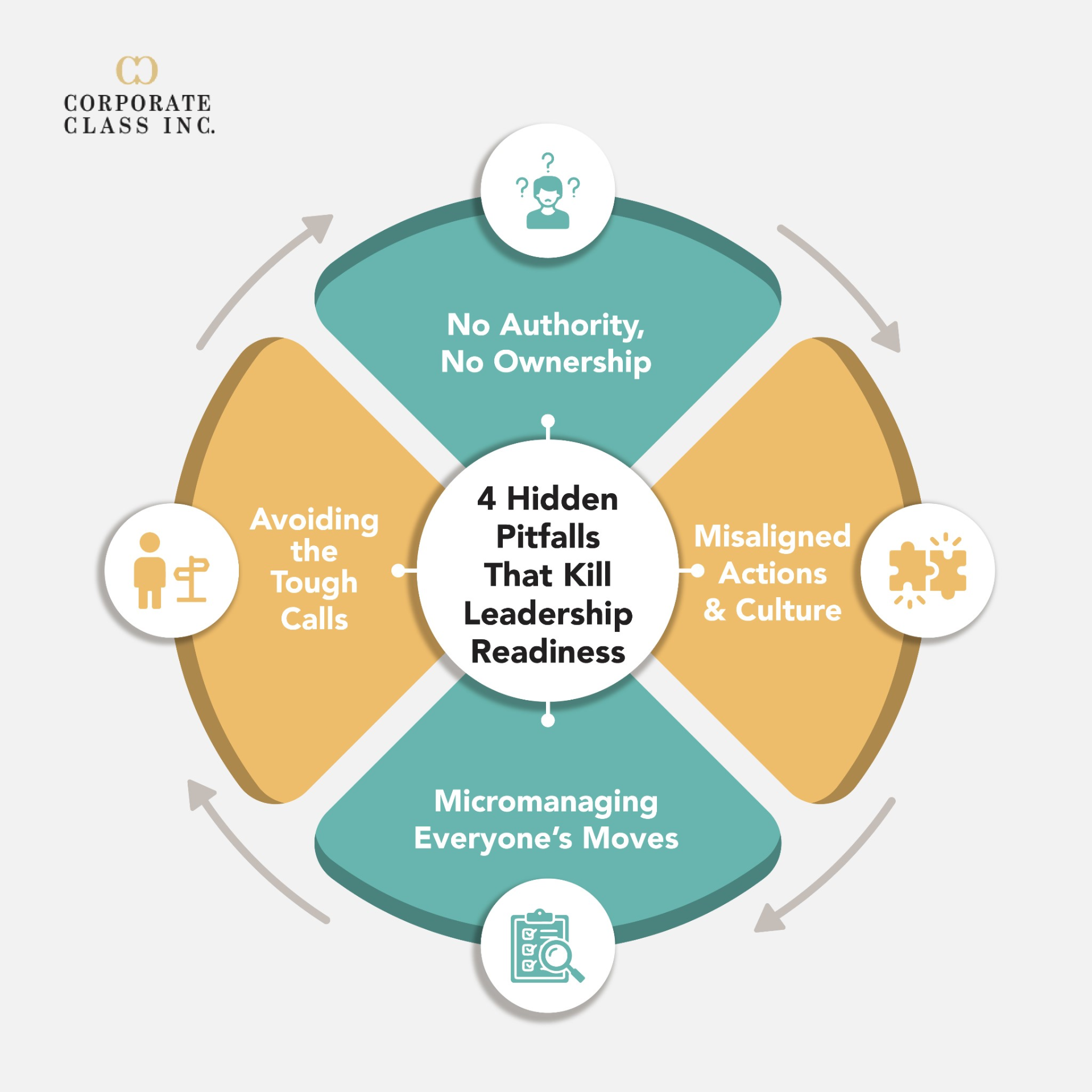Some leadership gaps don’t show up in performance reviews. They sit beneath the surface, quiet, persistent, and surprisingly common. If you’re aiming to lead a team, department, or company, you’ll want to spot these blind spots early. They affect your confidence, influence, and ability to drive change. In this guide, we’ll unpack four hidden factors that quietly undermine leadership readiness and offer ways to stay ahead of them.
Key Takeaways:
- Leadership readiness is often blocked by silent behaviours like micromanaging or avoiding hard conversations.
- Culture, empowerment, and executive modelling all shape how prepared you really are to lead.
- Being aware of hidden leadership gaps helps you avoid poor habits before they solidify.
What Makes a Good Leader?
Leadership goes beyond credentials or confidence. A good leader is someone others trust to take them somewhere worth going. That trust isn’t built through charm alone. It’s built through behaviour, consistency, and communication.
You don’t need to have all the answers. You need to make people feel like they’re part of a meaningful process. That includes how you:
- Communicate expectations and feedback
- Make decisions under pressure
- Share credit and take responsibility
- Show up during times of change
Leadership readiness means you’re equipped to guide people in different scenarios. It also means knowing what’s holding you back.
4 Critical Hidden Pitfalls that Kill Leadership Readiness

Even the most driven professionals can lose credibility because of habits they didn’t notice. These four issues don’t always show up as red flags. They tend to develop quietly.
1. Lack of Authority and Empowerment
If you’re constantly seeking permission or overexplaining every move, others may struggle to see you as a leader. This isn’t about acting like you have control, it’s about knowing when to take initiative and when to escalate.
Here’s how this shows up:
- You avoid final decisions until someone else weighs in
- Your team always checks with you before acting, even on small tasks
- You ask for consensus in moments that require a clear call
You can fix this by owning outcomes more publicly. Speak clearly about what you’re responsible for, and don’t hesitate to say, “Here’s my call on this.” Confidence is built by practicing action, not just analysis.
2. Failure of Executive Example and Culture Alignment
When your actions don’t match the leadership culture you promote, people notice. They may not say it aloud, but they feel the disconnect.
Let’s say you promote flexibility yet send emails late at night. Or you say team feedback matters, but you make final decisions in isolation. These behaviours erode trust quietly.
Leadership readiness requires culture alignment. This means living by the standards you set for others and showing the same discipline you ask of your team.
Explore Power Up Your Presentation Skills if you want to model stronger executive behaviour in public-facing situations.
3. Micromanagement and Overcontrol
Leaders often start as high performers. That makes it tempting to believe no one can do it as well as you. The problem? Micromanagement drives people away.
Here’s what overcontrol looks like:
- Constantly rewriting others’ work instead of coaching improvement
- Sitting in on meetings you don’t need to be part of
- Asking for updates too frequently, disrupting workflow
Your team grows when you let them carry responsibility. Instead of being the centre of every task, focus on developing others. You’ll still be involved, just more strategically.
4. Prioritizing Being Liked Over Making Tough Decisions
Trying to stay likable in every room is exhausting. More importantly, it weakens your leadership. Your role isn’t to please everyone. It’s to lead with clarity, fairness, and courage.
This doesn’t mean being cold or distant. It means understanding that leadership requires decisions that won’t always be popular. And that’s okay.
Here’s how this pitfall shows up:
- Avoiding conflict to “keep the peace”
- Delaying hard conversations until the issue grows
- Agreeing in meetings, disagreeing later in private
Instead of choosing likability, choose consistency. People respect leaders who are clear and kind, even when the message is firm.
Learn with expert coaches who’ve trained global leaders.
Identifying and Overcoming Leadership Pitfalls Early
Recognizing leadership pitfalls early puts you in a better position to correct them before they set in. You don’t need to start over or change your personality. What you need is awareness, intention, and the ability to course-correct quickly. Small decisions, made consistently, can shape your leadership readiness more than one-time efforts.
To begin, start with honest reflection. Think back to moments when your leadership felt off-track. Did you hesitate when clarity was needed? Did your team seem confused, disengaged, or hesitant to act without you?
From there, use simple tools and daily habits to uncover gaps and build better patterns:
- Track feedback themes: Pay attention to repeated feedback, even subtle comments. Are there signs you’re unclear, too hands-on, or hard to approach?
- Ask better questions: Instead of general check-ins, ask “Where could I be clearer in my expectations?” or “Is there anything slowing us down that I’m not seeing?”
- Watch your calendar: Review how much time you spend supervising vs. enabling. If most of your day involves approvals and revisions, there may be trust or delegation issues.
- Practice short reflection moments: After a meeting or decision, take 60 seconds to ask yourself, “Did I empower others just now?” or “Did I show up the way I want others to model?”
- Use structured tools: Leadership assessments, 360 reviews, and coaching conversations reveal what might be hiding in plain sight.
- Review your digital footprint: Emails, meeting recordings, and team chats often expose tone, clarity, or pace you didn’t notice in real time.
You can also learn from others who’ve worked through these same gaps. Browse through CCI’s video library to observe effective leadership in different formats. Seeing confident leaders in action can help you notice what to adjust in your own style.
By making these checks routine, you train your awareness like a muscle. Each small adjustment builds your confidence and sharpens your leadership readiness—without waiting for someone else to point it out.
FAQ
What if I don’t feel ready to lead, even after training?
It’s common to question your readiness. Confidence grows through repeated action and reflection. Even seasoned leaders revisit foundational skills to stay sharp. Training equips you with tools, but using them builds strength. You don’t need to be perfect, you need to keep showing up and learning.
Can leadership readiness apply outside of executive roles?
Yes. Leadership readiness applies to team leads, project managers, and even entry-level professionals who want to grow. It’s about how you communicate, support others, and make decisions, not just your title. The earlier you build these habits, the easier it becomes to lead when the opportunity arises.
How can I get honest feedback without formal reviews?
Try asking your colleagues questions like, “What’s one thing I could do to support you better?” or “When do you feel least clear on what I expect?” These questions open space for useful feedback without making things uncomfortable. Peer feedback often reveals gaps that formal reviews miss.
Pitfalls Can Be Signs of Redirection and Guidance
If you’ve noticed any of these hidden pitfalls, don’t panic. Spotting them means you’re already developing stronger awareness, a critical part of leadership readiness. Every leader grows through small corrections. Your job is to stay curious, consistent, and open to change.
By identifying what’s holding you back, you can lead with more clarity and courage. You’re not just preparing to lead, you’re becoming the kind of person others want to follow.
Work with coaches who understand what leaders need at every stage





